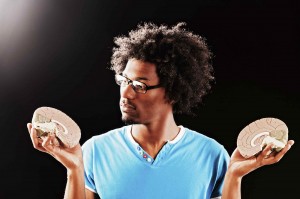Two Brains. So What?

Alas, poor System 1…
We have two different thinking systems in our brain, often called System 1 and System 2. System 1 is fast and automatic and makes up to 95% of our decisions. System 2 is a slow energy hog that allows us to think through issues consciously. When we think of thinking, we’re thinking of System 2.
You might ask: Why would this matter to anyone other than neuroscientists? It’s interesting to know but does it have any practical impact? Well, here are some things that we might want to change based on the dual-brain idea.
Economic theory – our classic economic theories depend on the notion of rational people making rational decisions. As Daniel Kahneman points out, that’s not the way the world works. For instance, our loss aversion bias pushes us towards non-rational investment decisions. (See also here). It happens all the time and has created a whole new school of thought called behavioral economics (and a Nobel prize for Kahneman).
Intelligence testing – System 1 makes up to 95% of our decisions but our classic IQ tests focus exclusively on System 2. That doesn’t make sense. We need new tests that incorporate rationality as well as intelligence.
Advertising – we often measure the effectiveness of advertising through awareness tests. Yet System 1 operates below the threshold of awareness. We can know things without knowing that we know them. As Peter Steidl points out, if we make 95% of our decisions in System 1, doesn’t it also follow that we make (roughly) 95% of our purchase decisions in System 1? Branding should focus on our habits and memory rather than our awareness.
Habits (both good and bad) – we know that we shouldn’t procrastinate (or smoke or eat too much, etc.). We know that in System 2, our conscious self. But System 2 doesn’t control our habits; System 1 does. In fact, John Arden calls System 1 the habitual brain. If we want to change our bad habits (or reinforce our goods ones), we need to change the habits and rules stored in System 1. How do we do that? Largely by changing our memories.
Judgment, probability, and public policy – As Daniel Kahneman points out, humans are naturally good at grammar but awful at statistics. We create our mental models in System 1, not System 2. How frequently does something happen? We estimate probability based on how easy it is to retrieve memories. What kinds of memories are easy to retrieve? Any memory that’s especially vivid or scary. Thus, we overestimate the probability of violent crime and underestimate the probability of good deeds. We make policy decisions and public investments based on erroneous – but deeply held – predictions.
Less logic, louder voice – people who aren’t very good at something tend to overestimate their skills. It’s the Dunning-Kruger effect – people don’t recognize their own ineptitude. It’s an artifact of System 1. Experts will often craft their conclusions very carefully with many caveats and warnings. Non-experts don’t know that their expertise is limited; they simply assume that they’re right. Thus, they often speak more loudly. It’s the old saying: “He’s seldom right but never in doubt”.
Teaching critical thinking – I’ve read nearly two-dozen textbooks on critical thinking. None of them give more than a passing remark or two on the essential differences between System 1 and System 2. They focus exclusively on our conscious selves: System 2. In other words, they focus on how we make five per cent of our decisions. It’s time to re-think the way we teach thinking.